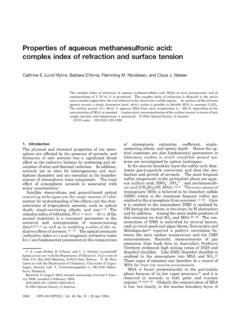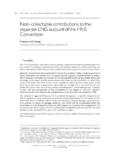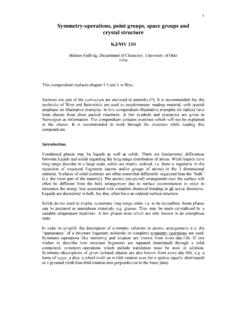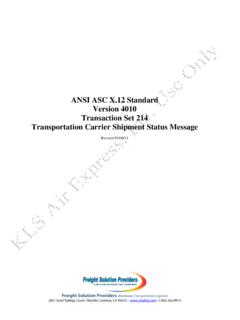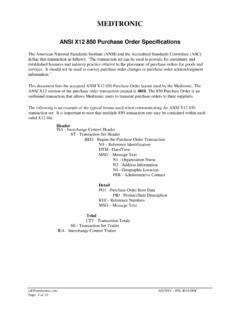Transcription of Standard Methods for the Examination of ... - folk.uio.no
1 Standard Methods for the Examination of Water and Wastewater Copyright 1999 by American Public Health Association, American Water Works Association, Water Environment Federation2320 ALKALINITY*#(1)2320 A. Introduction1. Discussion Alkalinity of a water is its acid-neutralizing capacity. It is the sum of all the titratable measured value may vary significantly with the end-point pH used. Alkalinity is a measureof an aggregate property of water and can be interpreted in terms of specific substances onlywhen the chemical composition of the sample is known. Alkalinity is significant in many uses and treatments of natural waters and the alkalinity of many surface waters is primarily a function of carbonate, bicarbonate,and hydroxide content, it is taken as an indication of the concentration of these constitutents.
2 Themeasured values also may include contributions from borates, phosphates, silicates, or otherbases if these are present. Alkalinity in excess of alkaline earth metal concentrations is significantin determining the suitability of a water for irrigation. Alkalinity measurements are used in theinterpretation and control of water and wastewater treatment processes. Raw domesticwastewater has an alkalinity less than, or only slightly greater than, that of the water operating anaerobic digesters typically have supernatant alkalinities in the range of 2000to 4000 mg calcium carbonate (CaCO3) 2. Reference 1.
3 POHLAND, & BLOODGOOD. 1963. Laboratory studies on mesophilic andthermophilic anaerobic sludge digestion. J. Water Pollut. Control Fed. 35 B. Titration Method1. General Discussiona. Principle: Hydroxyl ions present in a sample as a result of dissociation or hydrolysis ofsolutes react with additions of Standard acid. Alkalinity thus depends on the end-point pH Methods of determining inflection points from titration curves and the rationale for titratingto fixed pH end points, see Section For samples of low alkalinity (less than 20 mg CaCO3/L) use an extrapolation techniquebased on the near proportionality of concentration of hydrogen ions to excess of titrant beyondthe equivalence point.
4 The amount of Standard acid required to reduce pH exactly pH unit ismeasured carefully. Because this change in pH corresponds to an exact doubling of the hydrogenStandard Methods for the Examination of Water and Wastewater Copyright 1999 by American Public Health Association, American Water Works Association, Water Environment Federationion concentration, a simple extrapolation can be made to the equivalence ,2 b. End points: When alkalinity is due entirely to carbonate or bicarbonate content, the pH atthe equivalence point of the titration is determined by the concentration of carbon dioxide (CO2)at that stage.
5 CO2 concentration depends, in turn, on the total carbonate species originally presentand any losses that may have occurred during titration. The pH values in Table 2320:I aresuggested as the equivalence points for the corresponding alkalinity concentrations as milligramsCaCO3 per liter. Phenolphthalein alkalinity is the term traditionally used for the quantitymeasured by titration to pH irrespective of the colored indicator, if any, used in thedetermination. Phenolphthalein or metacresol purple may be used for alkalinity titration to Bromcresol green or a mixed bromcresol green-methyl red indicator may be used for pH c.
6 Interferences: Soaps, oily matter, suspended solids, or precipitates may coat the glasselectrode and cause a sluggish response. Allow additional time between titrant additions to letelectrode come to equilibrium or clean the electrodes occasionally. Do not filter, dilute,concentrate, or alter sample. d. Selection of procedure: Determine sample alkalinity from volume of Standard acidrequired to titrate a portion to a designated pH taken from 1b. Titrate at room temperature witha properly calibrated pH meter or electrically operated titrator, or use color indicators. If usingcolor indicators, prepare and titrate an indicator blank.
7 Report alkalinity less than 20 mg CaCO3/L only if it has been determined by thelow-alkalinity method of 4d. Construct a titration curve for standardization of reagents. Color indicators may be used for routine and control titrations in the absence of interferingcolor and turbidity and for preliminary titrations to select sample size and strength of titrant (seebelow). e. Sample size: See Section for selection of size sample to be titrated and normalityof titrant, substituting or sulfuric (H2SO4) or hydrochloric (HCl) acid for thestandard alkali of that method. For the low-alkalinity method, titrate a 200-mL sample H2SO4 from a 10-mL Sampling and storage: See Section Apparatus See Section 3.
8 Reagentsa. Sodium carbonate solution, approximately : Dry 3 to 5 g primary Standard Na2CO3at 250 C for 4 h and cool in a desiccator. Weigh g (to the nearest mg), transfer to a 1-Lvolumetric flask, fill flask to the mark with distilled water, and dissolve and mix reagent. Do notkeep longer than 1 Methods for the Examination of Water and Wastewater Copyright 1999 by American Public Health Association, American Water Works Association, Water Environment Federationb. Standard sulfuric acid or hydrochloric acid, : Prepare acid solution of approximatenormality as indicated under Preparation of Desk Reagents.
9 Standardize against mL solution, with about 60 mL water, in a beaker by titrating potentiometrically to pH ofabout 5. Lift out electrodes, rinse into the same beaker, and boil gently for 3 to 5 min under awatch glass cover. Cool to room temperature, rinse cover glass into beaker, and finish titrating tothe pH inflection point. Calculate normality: where: A = g Na2CO3 weighed into 1-L flask, B = mL Na2CO3 solution taken for titration, and C = mL acid used. Use measured normality in calculations or adjust to ; 1 mL solution = mgCaCO3.
10 C. Standard sulfuric acid or hydrochloric acid, : Dilute mL standardacid to 1000 mL with distilled or deionized water. Standardize by potentiometric titration mL Na2CO3 according to the procedure of 3b; 1 mL = mg Bromcresol green indicator solution, pH indicator: Dissolve 100 mg bromcresol green,sodium salt, in 100 mL distilled Mixed bromcresol green-methyl red indicator solution:3 Use either the aqueous or thealcoholic solution:1) Dissolve 100 mg bromcresol green sodium salt and 20 mg methyl red sodium salt in 100mL distilled water. 2) Dissolve 100 mg bromcresol green and 20 mg methyl red in 100 mL 95% ethyl alcohol orisopropyl alcohol.
